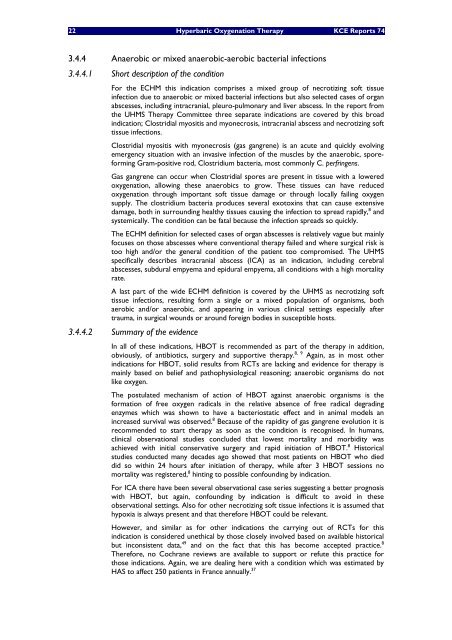Hyperbare Zuurstoftherapie: Rapid Assessment - KCE
Hyperbare Zuurstoftherapie: Rapid Assessment - KCE
Hyperbare Zuurstoftherapie: Rapid Assessment - KCE
Create successful ePaper yourself
Turn your PDF publications into a flip-book with our unique Google optimized e-Paper software.
22 Hyperbaric Oxygenation Therapy <strong>KCE</strong> Reports 74<br />
3.4.4 Anaerobic or mixed anaerobic-aerobic bacterial infections<br />
3.4.4.1 Short description of the condition<br />
For the ECHM this indication comprises a mixed group of necrotizing soft tissue<br />
infection due to anaerobic or mixed bacterial infections but also selected cases of organ<br />
abscesses, including intracranial, pleuro-pulmonary and liver abscess. In the report from<br />
the UHMS Therapy Committee three separate indications are covered by this broad<br />
indication; Clostridial myositis and myonecrosis, intracranial abscess and necrotizing soft<br />
tissue infections.<br />
Clostridial myositis with myonecrosis (gas gangrene) is an acute and quickly evolving<br />
emergency situation with an invasive infection of the muscles by the anaerobic, sporeforming<br />
Gram-positive rod, Clostridium bacteria, most commonly C. perfringens.<br />
Gas gangrene can occur when Clostridial spores are present in tissue with a lowered<br />
oxygenation, allowing these anaerobics to grow. These tissues can have reduced<br />
oxygenation through important soft tissue damage or through locally failing oxygen<br />
supply. The clostridium bacteria produces several exotoxins that can cause extensive<br />
damage, both in surrounding healthy tissues causing the infection to spread rapidly, 8 and<br />
systemically. The condition can be fatal because the infection spreads so quickly.<br />
The ECHM definition for selected cases of organ abscesses is relatively vague but mainly<br />
focuses on those abscesses where conventional therapy failed and where surgical risk is<br />
too high and/or the general condition of the patient too compromised. The UHMS<br />
specifically describes intracranial abscess (ICA) as an indication, including cerebral<br />
abscesses, subdural empyema and epidural empyema, all conditions with a high mortality<br />
rate.<br />
A last part of the wide ECHM definition is covered by the UHMS as necrotizing soft<br />
tissue infections, resulting form a single or a mixed population of organisms, both<br />
aerobic and/or anaerobic, and appearing in various clinical settings especially after<br />
trauma, in surgical wounds or around foreign bodies in susceptible hosts.<br />
3.4.4.2 Summary of the evidence<br />
In all of these indications, HBOT is recommended as part of the therapy in addition,<br />
obviously, of antibiotics, surgery and supportive therapy. 8, 9 Again, as in most other<br />
indications for HBOT, solid results from RCTs are lacking and evidence for therapy is<br />
mainly based on belief and pathophysiological reasoning; anaerobic organisms do not<br />
like oxygen.<br />
The postulated mechanism of action of HBOT against anaerobic organisms is the<br />
formation of free oxygen radicals in the relative absence of free radical degrading<br />
enzymes which was shown to have a bacteriostatic effect and in animal models an<br />
increased survival was observed. 8 Because of the rapidity of gas gangrene evolution it is<br />
recommended to start therapy as soon as the condition is recognised. In humans,<br />
clinical observational studies concluded that lowest mortality and morbidity was<br />
achieved with initial conservative surgery and rapid initiation of HBOT. 8 Historical<br />
studies conducted many decades ago showed that most patients on HBOT who died<br />
did so within 24 hours after initiation of therapy, while after 3 HBOT sessions no<br />
mortality was registered, 8 hinting to possible confounding by indication.<br />
For ICA there have been several observational case series suggesting a better prognosis<br />
with HBOT, but again, confounding by indication is difficult to avoid in these<br />
observational settings. Also for other necrotizing soft tissue infections it is assumed that<br />
hypoxia is always present and that therefore HBOT could be relevant.<br />
However, and similar as for other indications the carrying out of RCTs for this<br />
indication is considered unethical by those closely involved based on available historical<br />
but inconsistent data, 49 and on the fact that this has become accepted practice. 8<br />
Therefore, no Cochrane reviews are available to support or refute this practice for<br />
those indications. Again, we are dealing here with a condition which was estimated by<br />
HAS to affect 250 patients in France annually. 37

















